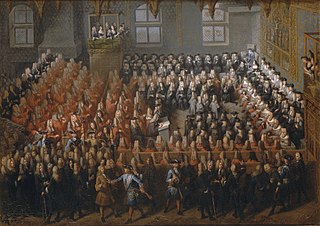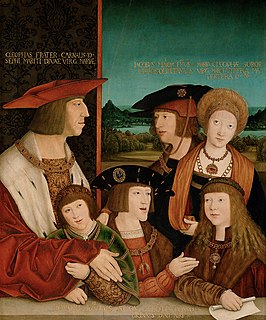Related Research Articles

The Peasants' Revolt, also named Wat Tyler's Rebellion or the Great Rising, was a major uprising across large parts of England in 1381. The revolt had various causes, including the socio-economic and political tensions generated by the Black Death in the 1340s, the high taxes resulting from the conflict with France during the Hundred Years' War, and instability within the local leadership of London.

Philip IV, also called the Planet King, was King of Spain from 1621 to his death and King of Portugal from 1621 to 1640. Philip is remembered for his patronage of the arts, including such artists as Diego Velázquez, and his rule over Spain during the Thirty Years' War.

Fuero, Fur, Foro or Foru is a Spanish legal term and concept. The word comes from Latin forum, an open space used as a market, tribunal and meeting place. The same Latin root is the origin of the French terms for and foire, and the Portuguese terms foro and foral; all of these words have related, but somewhat different meanings.

The Flemish peasant revolt of 1323–1328, sometimes referred to as the Flemish coast uprising in historical writing, was a popular revolt in late medieval Europe. Beginning as a series of scattered rural riots in late 1323, peasant insurrection escalated into a full-scale rebellion that dominated public affairs in Flanders for nearly five years until 1328. The uprising in Flanders was caused by both excessive taxations levied by the Count of Flanders Louis I, and by his pro-French policies. The insurrection had urban leaders and rural factions which took over most of Flanders by 1325.

The Parliament of Paris was the oldest parlement in the Kingdom of France, formed in the 13th century. It was fixed in Paris by Philip IV of France in 1302. The Parliament of Paris would hold sessions inside the medieval royal palace on the Île de la Cité, nowadays still the site of the Paris Hall of Justice.
A salt tax refers to the direct taxation of salt, usually levied proportionately to the volume of salt purchased. The taxation of salt dates as far back as 300BC, as salt has been a valuable good used for gifts and religious offerings since 6050BC. The salt tax originated in China, in 300BC and became the main source of financing the Great Wall As a result of the successful profitability of the Salt Tax, it began filtering through the rulings of nations across the world, France, Spain, Russia, England and India were the main regions to follow the Chinese lead. Salt was used as a currency during the Roman Empire and towards the end of their reign, the Romans began monopolising salt in order to fund their war objectives. Salt was such an important commodity during the Middle Ages that governments would often incorporate the salt trade as a state enterprise. Salt is one of the longest standing sources of revenue for governments, the taxation policy was so successful due to the vital role of salt within the human diet. Salt Taxing has been extremely influential in many of the political and economic revolts within history,resulting in important historic events including the French Revolution, the Moscow Salt Riot, the Salt March in India, and the Salt Tax Revolt in Spain.
The Revolt of the Comuneros was a popular uprising in the Viceroyalty of New Granada against the Spanish authorities from March through October 1781. The revolt was in reaction to the increase in taxation to raise funds for defense of the region against the British, a rise in the price of tobacco and brandy, which were part of the late eighteenth-century Bourbon reforms. The initial revolt was local and not well known outside the region of Socorro, but in the late nineteenth century, historian Manuel Briceño saw the massive revolt as a precursor to independence. Prior to the 1781 revolt, residents in New Granada had protested, at times violently, crown policy implementation there between 1740 and 1779.

The Revolt of the Comuneros was an uprising by citizens of Castile against the rule of Charles I and his administration between 1520 and 1521. At its height, the rebels controlled the heart of Castile, ruling the cities of Valladolid, Tordesillas, and Toledo.

The Reapers' War, also known as the Catalan Revolt, was a conflict that affected a large part of the Principality of Catalonia between the years of 1640 and 1659. It had an enduring effect in the Treaty of the Pyrenees (1659), which ceded the County of Roussillon and the northern half of the County of Cerdanya to France, splitting these northern Catalan territories off from the Principality of Catalonia and the Crown of Aragon, and thereby receding the borders of Spain to the Pyrenees.

The Bourbon Reforms consisted of political and economical legislation promulgated by the Spanish Crown under various kings of the House of Bourbon, since 1700, mainly in the 18th century. The beginning of the new Crown's power with clear lines of authority to officials contrasted to the complex system of government that evolved under the Habsburg monarchs. For example, the crown pursued state supremacy over the Catholic Church, pushed economic reforms, and placed power solely into the hands of civil officials.

The Franco-Spanish War (1635–1659) was fought between France and Spain, with the participation of a changing list of allies through the war. The first phase, beginning in May 1635 and ending with the 1648 Peace of Westphalia, is considered a related conflict of the Thirty Years' War. The second phase continued until 1659 when France and Spain agreed to peace terms in the Treaty of the Pyrenees.

The Revolt of the Brotherhoods was a revolt by artisan guilds (Germanies) against the government of King Charles V in the Kingdom of Valencia, part of the Crown of Aragon. It took place from 1519–1523, with most of the fighting occurring during 1521. The Valencian revolt inspired a related revolt in the island of Majorca, also part of Aragon, which lasted from 1521–1523.

The Rebellion of Túpac Amaru II was an uprising of native and mestizo peasants with creole and mestizo support, led by indigenous caciques against the beneficiaries of the Bourbon reforms in the Spanish Viceroyalty of Peru. Other causes included widespread economic downturn and a revival of Inca identity embodied by Túpac Amaru II, a native cacique and the original leader of the rebellion. While Túpac Amaru II was captured and executed in 1781, the rebellion continued for at least another year under other leaders.
The Dutch Revolt (1566–1648) was the revolt in the Low Countries against the rule of the Habsburg King Philip II of Spain, hereditary ruler of the provinces. The northern provinces eventually separated from the southern provinces, which continued under Habsburg Spain until 1714. The northern provinces adopted Calvinism and Republicanism whereas the southern provinces became wholly Catholic again due to the expulsion of Protestants and the efforts of the Counter-Reformation and remained under absolutist rule. The Dutch Revolt has been viewed as the seedbed of the major democratic revolutions from England, to America to France.

Gaspar de Guzmán y Pimentel, 1st Duke of Sanlúcar, 3rd Count of Olivares, GE, known as the Count-Duke of Olivares, was a Spanish royal favourite of Philip IV and minister. As prime minister from 1621 to 1643, he over-exerted Spain in foreign affairs and unsuccessfully attempted domestic reform. His policy of committing Spain to recapture Holland led to a renewal of the Eighty Years' War while Spain was also embroiled in the Thirty Years' War (1618–1648). In addition, his attempts to centralise power and increase wartime taxation led to revolts in Catalonia and in Portugal, which brought about his downfall.
The Single whip law or the "Single whip reform" was a fiscal law first instituted during the middle Ming dynasty, in the early 16th century, and then promulgated throughout the empire in 1580 by Zhang Juzheng.

In the period 1482–1492, the cities of the County of Flanders revolted twice against Maximilian of Austria, who ruled the county as regent for his son, Philip the Handsome. Both revolts were ultimately unsuccessful.

The Angelets, or “the Angelets of the Earth”, were peasants who rose up from 1667 to 1675 against the French authorities of the Roussillon province; the group of conflicts of the period is called the Revolt of the Angelets. The cause was the instituting of the gabelle in 1661 — a measure contrary to traditional constitutions of the earldom.
A princely rebellion or princely revolt is an intrastate armed conflict by a prince against a reigning monarch of his own family, the ruling dynasty. A prince may rebel against a well-established monarch in order to seize the throne for himself immediately, to ensure his supposed right to sit on the throne in the future, or to secure other rights, privileges or interests such as appanages, alliances or sources of revenue that the monarch allegedly encroached upon, or failed to deliver or guarantee.
References
- ↑ Douglass, William A., ed. (1985). Basque politics: a case study in ethnic nationalism. Tarrytown, N.Y.: Associated Faculty Press. p. 127. ISBN 9780804693981.
- ↑ Kamen, Henry (2014). Spain, 1469-1714: A Society of Conflict (4th ed.). Hoboken: Taylor and Francis. p. 226. ISBN 9781317755005 . Retrieved 8 July 2017.
- ↑ Burg, David F. (2004). A World History of Tax Rebellions: An Encyclopedia of Tax Rebels, Revolts, and Riots from Antiquity to the Present. Routledge. ISBN 9781135959999 . Retrieved 8 July 2017.